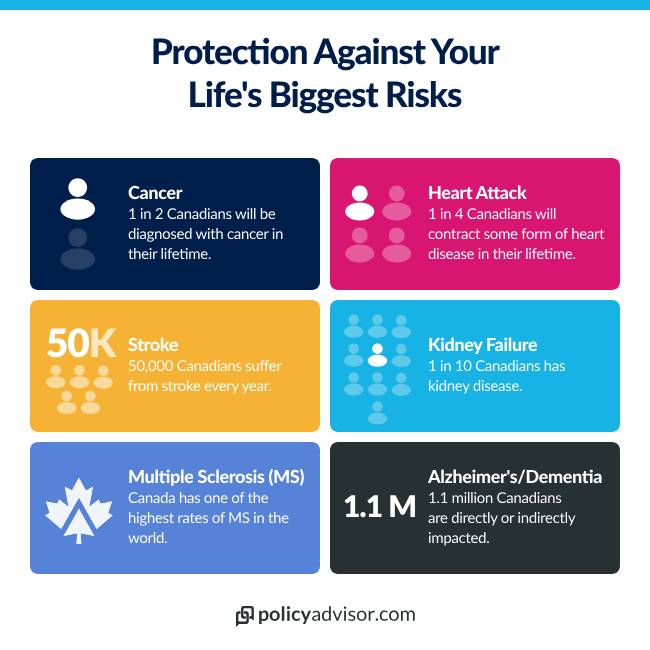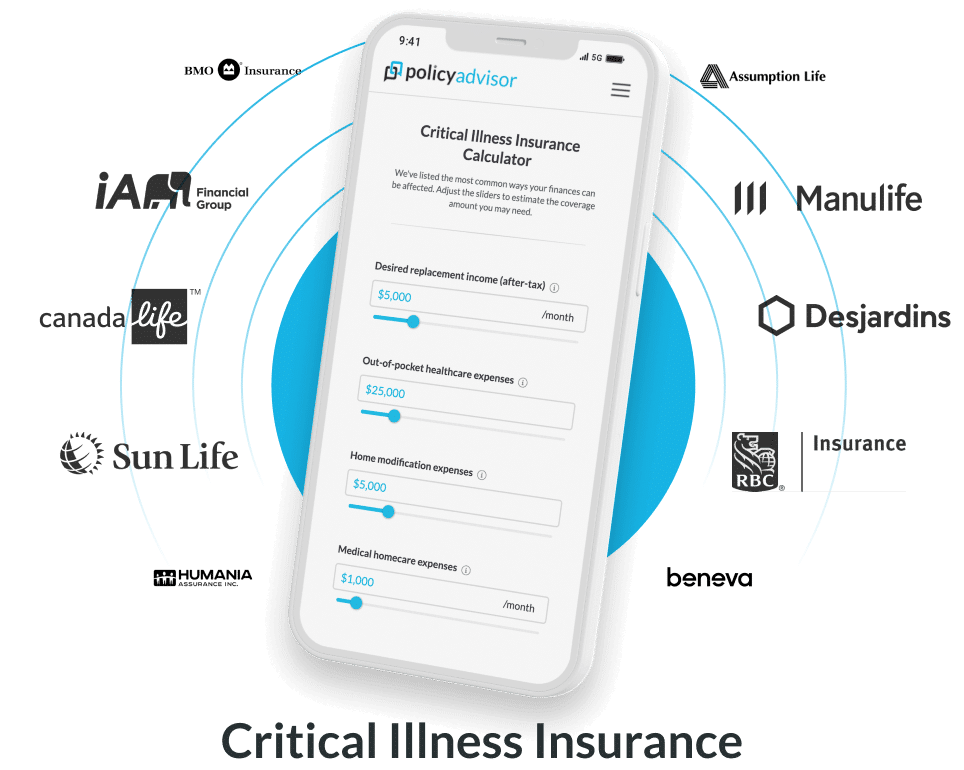- Children's critical illness insurance provides a lump sum payment if a child is diagnosed with a life-threatening illness. Coverage includes both general conditions and illnesses unique to children, like cerebral palsy and cystic fibrosis
- Premiums range from $10 to $50 per month, depending on factors such as the child’s age and the policy type. Stand-alone policies typically cost more but offer more comprehensive coverage than riders added to a parent's policy
- The policy helps cover medical expenses, compensates for lost income, and allows families to maintain financial stability by covering costs like mortgage payments or RESPs during a difficult time
- Parents can either purchase a stand-alone children’s critical illness policy or add a rider to their own critical illness insurance. Stand-alone policies offer higher coverage amounts, but riders are more affordable and can still offer good protection
Yes, you may need children’s critical illness insurance, especially if you want to ensure financial stability during challenging times. When your child is diagnosed with a critical illness, your focus should solely be on their recovery—not on the financial strain that often accompanies such situations.
Taking time off work, covering treatments or rehabilitation equipment can place immense stress on your entire family. Critical illness insurance allows you to prioritize your child’s care by protecting you financially.
What is critical illness insurance?
Critical illness insurance is a type of policy that provides a tax-free lump sum payment if the insured is diagnosed with a life-threatening illness or experiences a serious health event while the policy is active.
This coverage can be purchased as a standalone policy or added as a rider to a life insurance plan.
Unlike traditional life insurance, which provides benefits after the insured’s passing, critical illness insurance offers financial support while the insured is still alive.
This allows the individual and their family to manage the financial and emotional challenges that come with a serious medical diagnosis.

How much does children’s critical illness insurance cost?
The cost of children’s critical illness insurance typically ranges from $10 to $50 per month for a basic policy, depending on factors like the child’s age, coverage amount, and the insurer.
Stand-alone policies tend to have higher premiums than riders added to a parent’s policy, but they offer more comprehensive coverage. The cost can also vary based on the type of coverage selected, such as higher payout amounts or additional benefits.
What are the benefits of children’s critical illness?
Children’s critical illness insurance provides financial relief and flexibility for families facing a serious illness diagnosis. It helps cover medical costs, maintain financial stability, and ensures long-term affordable coverage for the child.
The various benefits offered by a children’s critical illness insurance plan are:
- Income support: Compensates for lost income if parents need to take time off work to care for their child
- Medical expense coverage: Covers treatments, prescription drugs, and therapies not covered by provincial healthcare plans
- Travel assistance: Covers travel and accommodation expenses for accessing specialized healthcare
- Financial stability: Helps maintain RESP, RRSP, or mortgage payments during reduced income periods
- Lifetime coverage: Offers guaranteed low premiums and allows coverage to continue into adulthood at affordable rates
- Flexible use of funds: The lump-sum payment can be used for any healthcare or personal needs unique to the family’s situation
What is limited pay children’s insurance?
Limited-pay policies represent a premium payment plan where you can pay for the policy for a set amount of time (sometimes 10 or 20 years).
After this time is up, you no longer have to pay premiums, but the coverage will stay in force. Your policy is considered fully paid up after the limited pay period is over
With some children’s critical illness policies, limited pay options are available. This means that if you purchase a critical illness policy for newborn, you pay for the first 20 years of their life only.
After that, the policy ownership can be transferred over to them and they get to keep the critical illness coverage for the rest of their life. Limited pay policies typically are the most expensive in premium payments since premiums are front-loaded.
What is ‘return of premiums’ on children’s policies?
Return of premiums is an optional feature that allows parents or children to receive a refund of all premiums paid if no claims are made on the policy during its term.
This feature is typically available after the 20-year limited pay period ends. The refunded amount can be used for various purposes, such as funding education, making a down payment on a house, or supporting business ventures. It offers added value and flexibility while ensuring the family’s financial security.
Does my critical illness policy cover my child?
Typically, a parent’s critical illness insurance policy only covers their own diagnosis, not that of a child or other loved ones. However, it is possible to add a rider to your policy to extend coverage to your child, including childhood-specific illnesses.
When adding this rider, your child’s coverage is tied to your policy. This means that if you cancel or let your policy expire, your child’s coverage will also be cancelled or expire.
Some insurers may only allow the addition of a children’s rider if you have an enhanced critical illness policy, rather than a basic one. It’s also important to note that riders may come with coverage limits, such as a $20,000 or $50,000 payout, depending on the insurer.
This is generally lower than what you could obtain by purchasing a stand-alone children’s critical illness policy, which can provide higher coverage amounts.
Which are the best insurance companies offering children’s critical illness?
At PolicyAdvisor, we work with top providers who offer both stand-alone children’s critical illness insurance and riders for existing policies. Notable companies offering critical illness policies include iA Financial Group, Canada Life, Desjardins Insurance, Beneva Insurance, etc.
For stand-alone children’s policies, the following insurance companies offer options:
- iA (Industrial Alliance) Financial Group
- Canada Life Insurance
- Desjardins Insurance
- Beneva Insurance
- Sun Life Insurance
You can also add a children’s critical illness insurance rider to your policy through products purchased from the following insurance companies:
When deciding which policy is best for your child, you must consider the amount of coverage offered, the conditions, and the cost of premiums.

What else can I do to protect my child?
In addition to children’s critical illness insurance, which can take care of financial needs if they fall ill, you can also purchase a children’s life insurance policy. These policies are purchased by a parent or guardian as either a rider on the parent’s policy or as a stand-alone policy for the child.
Children term riders are generally the least expensive way to obtain coverage for your child. Stand-alone life insurance policies for children are normally issued as whole-life products.
These stand-alone policies are guaranteed to remain in force for the covered child’s entire lifetime (including into adulthood) and generate dividends, creating a growing pool of investment resources and coverage for the child.
Frequently asked questions
Is children’s critical illness insurance covered in health insurance?
No, children’s critical illness insurance is not included in health insurance plans and must be purchased separately. Standard health insurance in Canada only covers medical treatments, prescriptions, and routine care.
Does critical illness insurance cover pre-existing conditions?
No, critical illness insurance typically does not cover pre-existing conditions, since they represent a higher risk to the providers. However, people with pre-existing conditions can still obtain critical illness coverage, though at a higher cost and with more limitations. These applicants usually have to provide a complete record of their diagnosis, treatment, and ongoing symptoms to qualify for coverage.
Can I add children’s critical illness coverage to my existing policy?
Yes, many insurance providers in Canada offer the option to add a children’s critical illness rider to a parent’s policy. This rider covers the child for specific conditions and is usually more affordable than a stand-alone policy. However, coverage limits may apply compared to stand-alone policies.
Is children’s critical illness insurance available for newborns?
Yes, many insurance providers in Canada offer children’s critical illness insurance for newborns. This coverage allows parents to secure protection for their child early, often at a lower premium, ensuring peace of mind in case of unforeseen health challenges.
Children’s critical illness insurance provides vital financial protection for families if a child is diagnosed with a life-threatening illness. This type of policy offers a lump sum payment to help cover medical expenses, lost income, and other costs during challenging times. Available as a stand-alone policy or an add-on rider to a parent’s existing critical illness insurance, it covers a wide range of conditions, including childhood-specific illnesses like cerebral palsy and cystic fibrosis. This coverage helps parents prioritize their child’s recovery without worrying about the financial strain.





